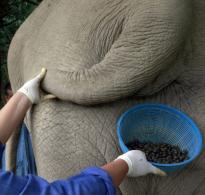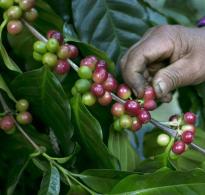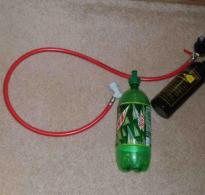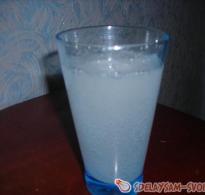On what fire to cook the jam. Stainless steel - a modern approach
Nowadays, when store shelves are literally bursting with a variety of jars of jams and marmalades, homemade jam has turned from an ordinary sweet treat into something much more. It has become a kind of symbol of a cozy home in which family harmony and prosperity reign. If you have not yet learned how to make jam, we advise you to quickly master this culinary wisdom.
What homemade jam is made from
For the preparation of any kind of jam, of course, sugar is required, since it is this sugar that is the preservative in this delicious dessert. Jam is made from almost all types of fruits and berries. Classic options are strawberry, cherry, black currant, raspberry, apricot or lingonberry jam. Also, gooseberries, peaches, quince, pears and small paradise apples are often used for jam. Fans of something more original can try to make jam from watermelon peels, green walnuts, dandelions or rose petals. In addition, some types of jam may require vanilla sugar, citric acid, nuts, and even ethyl alcohol (of course, in small quantities).
How to choose berries and fruits for jam
When choosing raw materials for future jam, try not to save on it if possible. Fruits and berries should be bought only selected - absolutely fresh, without specks and wormholes. The berries must be completely dry on top. If they have already started up the juice, which can be seen at the bottom of the container, then they are not suitable for jam. Almost all berries and fruits should be bought slightly unripe to keep their shape better during cooking.
Jam making
There are two main ways to make jam:
- An old classic recipe, which our grandmothers still used, prescribes to cook the fruits in pre-prepared concentrated sugar syrup. To prepare it, sugar and water in the quantities indicated in a specific recipe are placed in a bowl for making jam, put it on the fire, stir continuously and wait for the syrup to boil. After that, the heat is immediately reduced and the syrup is continued to cook until it is ready. The readiness indicator is as follows: the syrup flows from the spoon in a viscous wide ribbon, approximately the same way as honey flows down. Next, the fruits are immersed in the finished syrup and jam is made from them.
- The second method, which has become widespread in our time, is as follows: the prepared fruits are immediately placed in a bowl in layers, sprinkled with the necessary amount of granulated sugar, and when the berries are juiced after a while, they put the bowl on the stove and immediately begin to cook the jam.
During cooking, the jam is constantly stirred with a wooden spatula to prevent it from sticking, and the foam that forms on its surface is regularly carefully removed.
There is still no consensus among the housewives about how much jam should be cooked so that it is completely ready. Some believe that it is necessary to cook for a very short time - no more than 5-7 minutes, then the berries in the jam will not lose their color and all the vitamins will be preserved in them. The jam made in this way is popularly called "five-minute". It is, of course, very tasty, but it does not last long. Therefore, if you have enough time and are not in a hurry, it is still better to cook the jam according to the classical technology - in several steps. This is done like this: the jam is brought to a boil and immediately removed from the stove, then it cools down and infused for several hours. During this time, the berries are soaked in syrup and become denser. Then this cycle is repeated 2-3 more times, after which the jam is cooked until fully cooked and laid out in jars. Such jam is considered ready if the berries in it do not float to the surface and are evenly distributed in the thickness of the syrup. You can learn more about how much jam you need to cook until it is fully cooked from our other.
Now that you already know the basic rules for making jam, try to cook it yourself, for example, from apricots.
How to make apricot jam
To make such a jam, you will need three kilograms of apricots and two and a half kilograms of sugar. Apricots should be brightly colored, fragrant and slightly unripe. In addition, they should have a firm, but not sinewy flesh, from which the bone is easily separated.
- Apricots must be washed, dried, cut into halves along the natural groove and removed.
- The apricots prepared in this way must be laid out, sprinkled with sugar, in a bowl for jam. It is desirable that the basin is made of stainless steel. If you don't have one, you can take an enamel one. We leave the apricots in the basin for a few hours and wait for them to start juicing.
- We put the basin on the stove and, not forgetting to stir periodically, bring its contents to a boil. Then we reduce the heat and cook the jam for 5 minutes, regularly removing the foam that appears on it.
- Turn off the stove, remove the basin, put it in a suitable place and let the jam stand for about half a day.
- Then we repeat the whole process - let the jam boil, keep it on fire for the same five minutes, then remove it and leave it on the table to infuse for another 12 hours.
- For the third time, we cook the jam completely - mix well, remove the last foam and check the readiness. To do this, drip a little syrup on a saucer and see if it spreads. If the drop keeps its shape well, then the jam is completely ready. It must be removed from the heat and poured into jars.
How to make jam in a slow cooker
The jam, cooked in a multicooker, is very similar in taste and consistency to five-minute jam. Cooking it is very simple, the main thing is to correctly calculate the amount of products that you will put in the container. So that your jam does not "run away", the total amount of products should not exceed half the volume of your multicooker, that is, you need to put 1 kg in a 4 liter pan. sugar and 1 kg. berries or fruits. Next, you just need to remove the steam valve from the lid, put the prepared fruits in the multicooker container, fill them with sugar, close the multicooker and turn it on in the "Stew" mode for exactly one hour. In an hour, your jam will be ready.
"What to do?" - asked the impatient Petersburg youth. - “How to do what: if it's summer - peel the berries and make jam; if it's winter - drink tea with this jam. " Vasily Rozanov, "Embryos" cycle (1918).
Indeed, how great it is to open a jar of thick, bright homemade jam smelling of the summer sun and warmth! A delicacy that has preserved the taste, color and aroma of fresh berries can cheer you up, warm your soul and even bring people closer together during tea drinking ...
There are a number of techniques due to which the jam will turn out to be ideal not only in its taste, but also preserve all the vitamins and useful microelements that are necessary in the autumn-winter period.
The best preparations are obtained only from ripe, fresh and whole berries and fruits. Jam does not tolerate rot: it is better not to succumb to the temptation and not to buy rumpled discounted fruits.
To wash the fruits without damaging them, plug the sink with a stopper, draw in water and put them there to float, stirring gently with your hands. Then let the water drain.

After washing, you can remove the petioles and stalks. You don't need to do this before.
One of the most important nuances is sugar. Remember that berries are different, and the amount of sugar will depend on the sweetness of the raw materials. You can vary the ratio as you like, but keep in mind that excess sugar crystallizes during storage!

To set off the taste of the jam, make it more intense, you can use various additives, for example, vanilla perfectly complements raspberries, pears go well with cardamom and pink peppercorns, and cocoa is ideal for plums ... Try it!
Tableware
Our grandmothers cooked jam in copper basins. Such dishes provide uniform heating of the mass without burning, but does not contribute to the preservation of vitamins. Containers made of stainless steel are considered universal: they are durable and do not oxidize. Use a divider to avoid burning. It is also good to use enameled dishes, but provided that the enamel is completely intact.

Cooking
When heated, the berry-sugar mixture begins to actively bubble. Reduce heat; stir not too vigorously. Carefully remove the resulting foam in a separate bowl: it is so tasty!
A simple way to check the readiness of the jam: scoop the syrup with a teaspoon, pre-chilled in the freezer, cool and place again for 5 minutes in the freezer. Taking out the spoon again, you should see a thickened mass that holds its shape well.
Do not pour the jam into jars up to the very neck, leave 1–1.5 cm.

To avoid mold and spoilage of the product, first cover the neck of the jar with wax paper, and then only the lid.
Properly cooked and sealed, jam can be stored for up to 3 years. But what sweet tooth will have it for so long ?!
It's time for ripe berries, and it's time to think about harvesting them, namely how to cook the jam correctly.
Jam, this word is familiar to everyone from childhood, when our grandmothers cooked it and the aroma spread throughout the yard. Now we are grandmothers and make jam for our grandchildren.
Jam properly cooked this is when the shape of the berries and their aroma have been preserved.
How can this be achieved?
- The berries are sorted, washed and poured with hot sugar syrup, left for 2-3 hours to soak. During this time, the fruits will have time to absorb the syrup and will not wrinkle or boil during cooking.
But pre-fill alone is not enough. Depending on the density of the berries, jam cooking can be divided into several ways.
- Very delicate berries(raspberries, blackberries, strawberries, cherries, plums, sweet cherries, currants) are cooked in several stages with a break of 8-10 hours:
- 1 time - the syrup with berries is brought to a boil, and then put on "aging"
- 2 times - boil the jam for 10-15 minutes and again for "aging"
- 3 times - bring to readiness (over high heat).
2. Easy-boiling berries boil like this: boil a little in syrup, then take them out with a slotted spoon or strainer.
At this time, we bring the syrup to readiness and 5 minutes before the end of cooking, we again coat the berries. After the end of cooking, immediately roll it into jars.
3. Berries and fruits with a hard skin, such as gooseberries, ranet and plums before cooking, for better absorption of syrup, prick with a toothpick.
4. Black currant it is necessary to pre-blanch: for this, it is lowered into boiling water for 2-3 minutes, then we cool it. This must be done so that the berries are not dry in cold jam.
If we want to get jam from black currant, such as jam, you can skip the berry through a meat grinder, cover with sugar (1: 2), and leave for 6-8 hours to soak, and then bring to a boil and cork in pre-sterilized jars.
5. To prepare delicious chokeberry jam, you need to add apples (1: 5) or citric acid (2 grams per 1 kg of berries) to it.
Water can be replaced with red currant juice (2.5 cups per 1 kg of berries). The mountain ash must be pre-blanched for 3-5 minutes.
6. Apple jam cooked in several stages. For apples, it is necessary to do preliminary procedures: in order to avoid darkening, we wash them in a saline solution (1 tablespoon salt per liter of water), and then blanch for 3-5 minutes.
How much sugar and water should you put?
It depends on the degree of acidity of berries and fruits:
- for 1 kg of berries take from 1.2 to 1.5 kg of sugar
- water take from 2 to 2.5 cups per 1 kg of berries
How do you know that the jam is over?
There are several signs:
- foam should collect in the center, not at the edges
- fruits and berries should be evenly distributed in the syrup, and not float to the surface
- a drop of syrup on a plate should not blur
Vanillin or citric acid can be added to the jam at the end of cooking.
Jam storage
Jam is best kept in hermetically sealed glass jars. But there are options when the cans are closed with plastic lids, foil or parchment.
- If the jam is improperly cooked or stored at low temperatures, it can become sugar-coated. This is easy to fix - add 1-2 grams of citric acid and bring to a boil.
- If water gets into the finished jam or it is not cooked, and there is not enough sugar in it, then it can ferment. In this case, the jam is digested with a little sugar.
Enjoy your tea!
In the ripening season of berries and fruits, many housewives begin to preserve. However, not every woman knows which dish is best for cooking jam. After reading this article, you will learn a lot of interesting things on this issue.
A saucepan or a basin?
Many young housewives, who for the first time decided to do homework, often have a question: "In what dish is it better to cook jam?" As a rule, pots or pans are used for these purposes. Moreover, each of these options has its own advantages and disadvantages. For example, a saucepan is more convenient to use. In addition, it takes up much less space on the hob or worktop.
The advantage of the basin is its maximum open surface, which ensures better evaporation of excess liquid. Thanks to this feature, the jam cooked in it will be thicker. Moreover, the berries or fruits themselves will remain intact.
Preferred container sizes
For those who do not know in which dish it is better to cook jam, it will probably be interesting that it is advisable to do this in a shallow bowl with a flat wide bottom. Moreover, its volume can vary from two to six liters. It is not recommended to cook jam in large pots, since many types of berries, including raspberries and strawberries, can crumple under their own weight. As a result, you will end up with an unaesthetic boiled mass.

In addition, a container that is too large will take a long time to heat up, as a result of which there will be an increase in cooking time and a deterioration in the quality of the final product. Since many types of jam require repeated boiling, the pot used for this purpose must have a lid. It will provide additional protection against dust and insects.
Materials used to make such pots
A fairly wide range of different containers is presented in modern stores. Therefore, those who do not know in which dishes are better may by mistake acquire not quite what they need. To avoid such troubles, you should first familiarize yourself with the features of a particular material.

Many fruits and berries contain a large amount of organic acids, which serve as a catalyst for corrosive processes. Therefore, special requirements are imposed on the containers used for their preparation. For those who do not know in which dish it is better to cook berry jam, we can recommend buying a hygienic enameled one, or True, the first option has a relatively short service life. Noticing that even a small crack has appeared on the enamel surface, it is advisable to get rid of such a container.
The most suitable material is considered The pots made from it can be recommended to everyone who cannot decide which dish is best to cook in. Such containers are resistant to the acids contained in almost all berries and fruits.
What pots and pans are not suitable for making jam?
Copper containers, which have long been considered the best utensils for homework, are not entirely suitable for these purposes. As mentioned above, fruits contain an increased concentration of acids. Recent studies have shown that they are able to dissolve the patina that forms on the surface of pots. Therefore, those who have not yet decided in which dish it is better to cook jam should not do it in copper basins.

Aluminum containers are also categorically unsuitable for these purposes. Fruit acid contributes to the destruction of the oxide film formed on the walls of the dish. As a result of a complex chemical process, the release of aluminum molecules occurs, which subsequently enter the finished product.
At the end of the preparation of fruit or berry jam, you must thoroughly wash the pan, rinse it with hot water and dry it thoroughly. If you plan to prepare several batches of product from one type of raw material during the day, then you do not need to wash the dishes.
The enamelled container must not be cleaned with aggressive chemicals. You need to pour soda into it, add water and boil. After that, it is removed from the stove and left until morning.
Stainless steel pans are scratch resistant. Therefore, you can use powdered products to wash them. For example, they are perfectly cleaned with common salt. It is poured into a soiled bowl, poured with water, boiled and left for several hours. Then the contaminated areas are treated with a metal brush or a hard washcloth.
You can remove the remnants of burnt jam with husks. To do this, boil a whole unpeeled onion in a dish. The unpleasant odor that appears during this procedure disappears very quickly.
Everyone knows the taste of jam since childhood. Our grandmothers stocked up on them for future use to enjoy a sweet delicacy on cold winter evenings. But does everyone know how to cook it properly?
How to make jam properly
Winter jam is a slice of summer in a jar. How nice it is on frosty winter evenings to open a jar of jam and remember the warmth and the sun. The right jam looks very nice. In a thick, transparent syrup, berries or ripe fruit pieces are evenly distributed. Although some craftsmen can cook from zucchini, carrots or chestnuts. There is already someone in that much, but still there are general rules for cooking "summer in a bank".
- First of all, you need to seriously approach the selection of fruits for jam. Give preference to berries grown in your area. This reduces the risk of preserving harmful chemicals instead of healthy fruits for the winter. Slightly unripe fruits are best suited for jam. If you take overripe, there is a risk of getting an incomprehensible mess. Also, it will not have a positive effect on the beauty and taste of the product if you use raw materials with signs of spoilage - rot spots, damage from birds or insects, crumpled sides.
- The right dishes are very important in this matter. A copper, shallow basin is best suited. Make sure that the dishes are free of rust stains or green deposits. Enameled dishes are not suitable for the simple reason that everything in them most often burns. Which, of course, will spoil the taste of the finished product.
- Before you start cooking, the fruits must be carefully sorted out. Remove leaves, crumpled berries, seeds and stalks. It is also good to rinse everything in clean water.
- Properly prepared syrup is the most important thing in the preparation of this delicacy. The syrup is prepared like this - take an amount of sugar equal to the weight of the berries. If the raw material is 3 kg, then add 3 kg of sugar too. Plus, for every kilogram of sand, you need to add 200 g of water. Mix everything and bring to a boil over low heat. A good syrup will drain slowly from the spoon.
- After boiling, pour the berries into the syrup. You can, on the contrary, pour the syrup over the jars with the berries already decomposed and boil the whole mass.
When cooking, the proportions must be observed. If you put less sugar than according to the recipe, there is a risk that the jam will ferment. You need to pack it in glass jars with tin lids. To prevent the jam from becoming moldy, the jars must be dry and thoroughly washed. Also, the storage area for rolled up cans should also be dry and well ventilated.
How to make jam five minutes

As the name implies, this method is fast, easy and allows you to preserve the maximum amount of nutrients in berries and fruits.
To prepare in a quick way, the berries must be washed, sorted out of twigs, seeds and dried, then transferred to a deep basin and covered with sugar, stir and leave for several hours so that the berries or fruits give juice. Then put on the stove and, stirring, wait until it boils. After that, cook for another 5 minutes. If the jam is liquid, boil it again. You can also add a little citric acid if the finished jam is sugary. Then mix thoroughly and boil again.
You can add spices to the jam. For example, apples and pears go well with cinnamon. Orange - with cloves and cardamom.
How to make apple jam

When making apple jam:
- Wash the fruits, cut into pieces, removing the middle. For especially delicate apple jam, the fruits can be grated on a coarse grater, after removing the peel.
- Make sugar syrup by mixing sugar and water in proportion to 1 kilogram of sugar in 200 ml of water. Pour over apples. Simmer over high heat until the syrup thickens.
- Or cover the chopped apples with granulated sugar and leave for a couple of hours. Then bring the mixture to a boil.
- After the syrup is ready, pour the apple pulp into it and cook over high heat for 5 minutes. Then reduce and cook for another 5 minutes.
- Pour into jars and roll up a tin lid.
If the jam is liquid - what to do

The easiest way to thicken the jam is to add gelatin or agar-agar to it. Also for this purpose, you can add grated apple pulp, currants, lemon juice or orange peel to the jam. These pectin-containing natural products will not only add the desired thickness to the jam, but also add zest to its taste.
So that in the future the jam does not turn out to be too liquid, pay attention to the quality of the berries. Raw materials harvested in rainy weather become overly juicy. And therefore, it will take more time to digest the excess liquid. The same goes for freshly washed berries. Let the water drain off before adding the raw materials to the bowl.
Tips if the jam is very liquid:
- Remember to skim off the foam.
- Do not use a saucepan for cooking this delicacy - dishes with low walls will help excess moisture evaporate faster.
- Do not keep the product on fire for 3 hours in a row. Better to cook it in 3 steps. Boil the raw materials, keep on fire for 15 minutes. Then turn off the stove and cool the delicacy. Repeat 2 more times.
Mold on jam, what to do

If mold is found after opening the can, then you can simply remove it and eat the jam, since mold does not penetrate inside. You can also boil moldy jam with sugar, at the rate of 100 g of sand per 1 kg of jam. Keep on fire for 5-7 minutes. You should not roll up such jam again. Better rather than him.
Mold can occur if:
- The jam is poorly cooked.
- Not enough sugar was added.
- The lids were screwed on while still hot. Condensation will form when the jam jars are still hot. And excess moisture is mold's best friend.
- The jars were poorly cleaned or not sterilized.
- The finished product was stored in a humid room with poor air circulation.
If the jam is fermented

- Fermented jam can be boiled with sugar and put in jars. Calculation of 100 g of granulated sugar per 1 kg of jam.
- Add water to it and cook the compote. Keep in mind that in this case, the raw materials should not smell strongly of wine.
- Add as stuffing to. When heated in the stove, all alcohol compounds formed will decompose.
- Make your homemade fermented jam liqueur. Place suspicious cans closer to the battery. The bacteria will do their job on their own. It is better to remove the lid, and tie the neck of the jar with gauze folded in 1 layer. Usually the active fermentation process takes 2-3 days. And about 2-3 more weeks for the product to mature. The readiness of the filling can be determined by the absence of bubbles and the clarification of the infusion.
It also happens that the jam, on the contrary, is candied. This is due to the fact that the recipe was violated during cooking and a little more sugar was put in than it should have. This problem can be solved simply by placing the jars in warm water and heating the water to a boil. The sugar will dissolve. To avoid this in the future, it is recommended to add a little lemon juice or acid to each jar.





